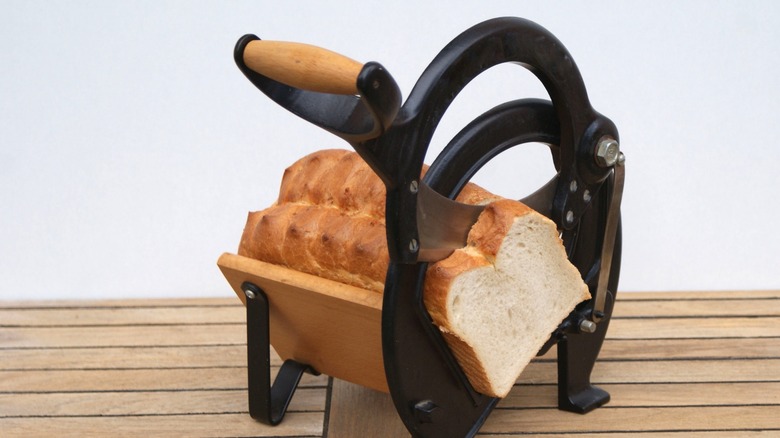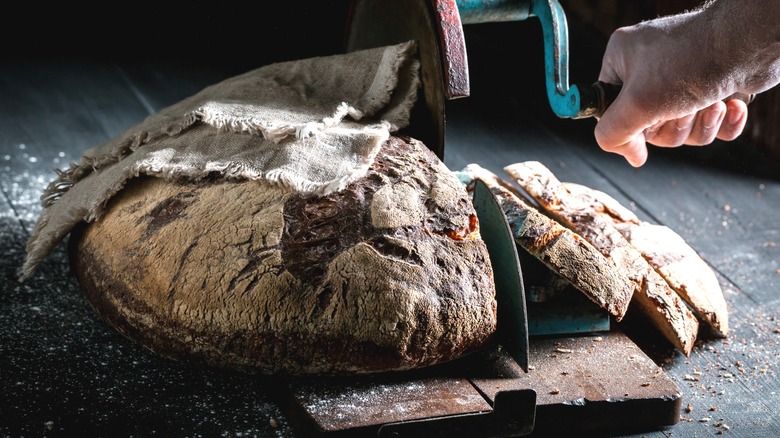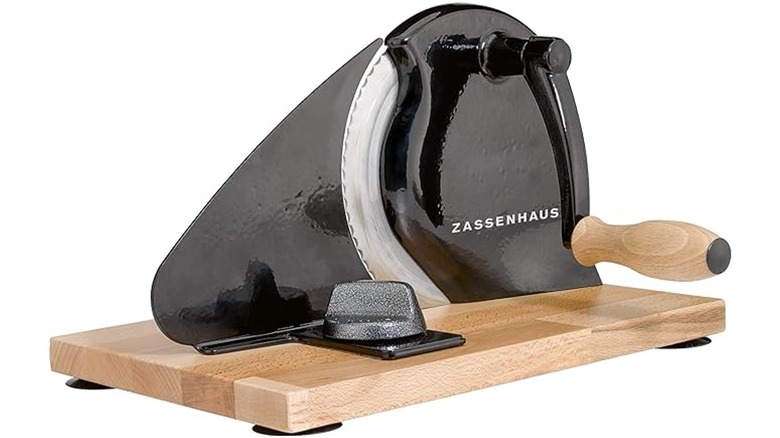Vintage Bread Slicers Should Require A License To Use
We may receive a commission on purchases made from links.
Long before Otto Rohwedder invented sliced bread in 1928, revolutionizing the baked goods industry, European manufacturers created novel bread-slicing equipment for households and restaurants, which are now collector's items. Although these vintage bread slicers could cut through crusty loaves of bread with ease and precision, their sharp, cleaver-like blades — which are brought down into the bread by a hand-operated crank or handle — are reminiscent of a medieval weapon, or perhaps a French guillotine or modern-day deli slicer. In other words, these are the type of kitchen appliance that screams "danger" to our modern sensibilities.
First manufactured in the early 1900s, companies like Raadvad, Hella, and Alexanderwerk built sturdy bread slicers made from iron, steel, and wood. These heavy countertop appliances were adjustable, so bakers could cut bread into slices of varying thicknesses. Although each company's model was slightly different, these slicers used two types of cutting techniques. Brands like Raadvad and Hella used a cleaver-type knife attached to a fulcrum that lobed off slices of bread like a paper cutter. Meanwhile, Alexanderwerk machines provided a circular blade that was manually spun with a crank. Unlike the serrated knives that many of us use today, these machines could easily be mistaken for a tool belonging to a woodworker.
How to find a vintage bread slicer
The Danish brand Raadvad is still in business after 250 years, though it was bought by Fiskar in 2015. Its popular 1970s-1980s bread slicer model, designed by artist Ove Larsen, has been discontinued, but like many other vintage bread slicers, it can be found on antique and auction sites. With the recent surge of popularity around home bread-making, vintage bread slicers have become a unique item for bakers to display in their homes or professional kitchens.
Sites like eBay, Etsy, and 1st Dibs sell guillotine-style bread slicers in a range of colors. Some models for sale are refinished, while others retain their original patina or stainless steel finishes. Their straight-edged blades can even be resharpened, though some units are sold as cookbook holders or kitchen decorations rather than functional slicers. Vintage bread slicers that still work are marketed as multi-purpose appliances that also slice cheese, fruit, sausages, and vegetables.
Vintage bread slicers retail between $140 to $600 for models in good shape that were manufactured before the 1960s. Unless you find a local seller, however, the cost to ship these Scandinavian collectibles — primarily located in the Netherlands and Denmark — can be almost as much as the retail price, if you live in another region.
Vintage-inspired bread slicers are also available
If you love the idea of a retro-style bread slicer, but prefer something unused (and perhaps a bit safer), companies like Zassenhaus sell vintage-inspired options. Zassenhaus' manual bread slicer features a hand-cranked blade and four suction cup feet to keep the slicer from moving. It is available in colors including black, cream, grey, red, and multicolor. Made in Germany, this countertop bread slicer has an adjustable serrated blade that allows users to slice 0.03 to 0.7 inches thick. A Zassenhaus retails for roughly $219. Other manufacturers like Ritter make both hand-operated and automatic slicers. These stainless steel kitchen gadgets also have serrated blades that are removable.
If you prefer a more modern way to cut bread, a long serrated knife is the best tool to slice all types of bread safely, effortlessly, and without squishing the bread down. Bread knives are traditionally 8" to 10" long to accommodate all-sized loaves, and they're also great at slicing slippery-skinned produce like tomatoes and peppers. For best results, try to cut perpendicular to your cutting board so the slices are even, and hold the knife vertically while keeping the bread steady.



